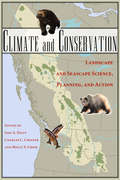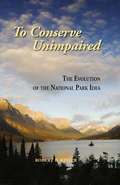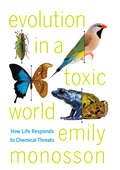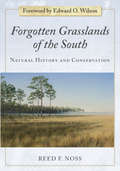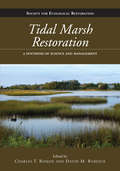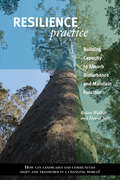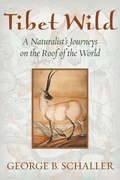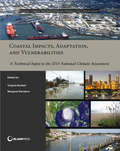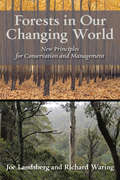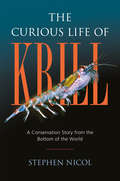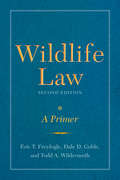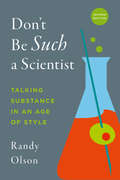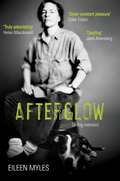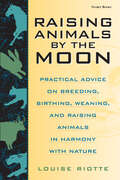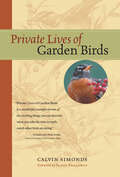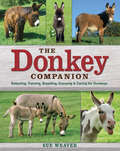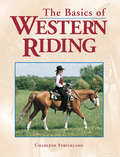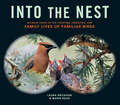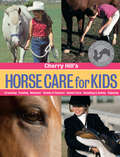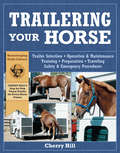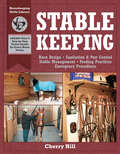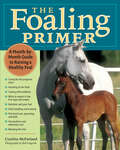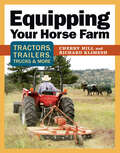- Table View
- List View
Climate and Conservation: Landscape and Seascape Science, Planning, and Action
by Jodi A. Hilty, Charles C. Chester and Molly S. CrossClimate and Conservation presents case studies from around the world of projects focused on climate change adaptation-regional-scale endeavors where scientists, managers, and practitioners are working to protect biodiversity by protecting landscapes and seascapes in response to threats posed by climate change.The book begins with an introductory section that frames the issues and takes a systematic look at planning for climate change adaptation. The nineteen chapters that follow examine particular case studies in every part of the world, including landscapes and seascapes from equatorial, temperate, montane, polar, and marine and freshwater regions.Climate and Conservation offers readers tangible, place-based examples of projects designed to protect large landscapes as a means of conserving biodiversity in the face of the looming threat of global climate change.
To Conserve Unimpaired: The Evolution of the National Park Idea
by Robert B. KeiterWhen the national park system was first established in 1916, the goal "to conserve unimpaired" seemed straightforward. But Robert Keiter argues that parks have always served a variety of competing purposes, from wildlife protection and scientific discovery to tourism and commercial development. In this trenchant analysis, he explains how parks must be managed more effectively to meet increasing demands in the face of climate, environmental, and demographic changes.Taking a topical approach, Keiter traces the history of the national park idea from its inception to its uncertain future. Thematic chapters explore our changing conceptions of the parks as wilderness sanctuaries, playgrounds, natural laboratories, and more, and the controversies that have ensued. Ultimately, Keiter demonstrates that parks cannot be treated as special islands, but must be managed as the critical cores of larger ecosystems.Professionals, students, and scholars with an interest in environmental history, national parks, and federal land management, as well as scientists and managers working on adaptation to climate change should find the book useful and inspiring.
Evolution in a Toxic World: How Life Responds to Chemical Threats
by Emily MonossonWith BPA in baby bottles, mercury in fish, and lead in computer monitors, the world has become a toxic place. But as Emily Monosson demonstrates in her groundbreaking new book, it has always been toxic. When oxygen first developed in Earth's atmosphere, it threatened the very existence of life: now we literally can't live without it. According to Monosson, examining how life adapted to such early threats can teach us a great deal about today's (and tomorrow's) most dangerous contaminants. While the study of evolution has advanced many other fields of science, from biology to medicine, toxicology has yet to embrace this critical approach. In Evolution in a Toxic World, Monosson seeks to change that.
Forgotten Grasslands of the South: Natural History and Conservation
by Reed F NossForgotten Grasslands of the South is the study of one of the biologically richest and most endangered ecosystems in North America. In a seamless blend of science and personal observation, renowned ecologist Reed Noss explains the natural history of southern grasslands, their origin and history, and the physical determinants of grassland distribution, including ecology, soils, landform, and hydrology.In addition to offering fascinating new information about these little-studied ecosystems, Noss demonstrates how natural history is central to the practice of conservation. Although theory and experimentation have recently dominated the field of ecology, ecologists are coming to realize how these distinct approaches are not divergent but complementary, and that pursuing them together can bring greater knowledge and understanding of how the natural world works and how we can best conserve it.This long-awaited work sets a new standard for scientific literature and is essential reading for those who study and work to conserve the grasslands of the South as well as for everyone who is fascinated by the natural world.
Tidal Marsh Restoration: A Synthesis of Science and Management (The Science and Practice of Ecological Restoration)
by Charles T. Roman and David M. BurdickTidal Marsh Restoration provides the scientific foundation and practical guidance necessary for coastal zone stewards to initiate salt marsh tidal restoration programs. The book compiles, synthesizes, and interprets the current state of knowledge on the science and practice of salt marsh restoration, bringing together leaders across a range of disciplines in the sciences (hydrology, soils, vegetation, zoology), engineering (hydraulics, modeling), and public policy, with coastal managers who offer an abundance of practical insight and guidance on the development of programs.The book is an essential work for managers, planners, regulators, environmental and engineering consultants, and others engaged in planning, designing, and implementing projects or programs aimed at restoring tidal flow to tide-restricted or diked salt marshes.
Resilience Practice: Building Capacity to Absorb Disturbance and Maintain Function
by Brian Walker David SaltResilience Thinking, published by Island Press in 2006, addressed an essential question: As the natural systems that sustain us are subjected to shock after shock, how much can they take and still deliver the services we need from them? Resilience Practice takes the notion of resilience one step further, applying resilience ideas to real-world situations and exploring how systems can be managed to promote and sustain resilience.Resilience Practice will help people with an interest in the "coping capacity" of systems—from farms and catchments to regions and nations—to better understand how resilience thinking can be put into practice. It offers an easy-to-read but scientifically robust guide through the real-world application of the concept of resilience and is a must read for anyone concerned with the management of systems at any scale.
Tibet Wild: A Naturalist's Journeys on the Roof of the World
by George B. SchallerGeorge Schaller has spent much of his life traversing wild and isolated places in his quest to understand and conserve threatened species—from mountain gorillas in the Virunga to snow leopards in the Himalaya. Throughout his career, Schaller has spent more time in Tibet than anywhere else, devoting over thirty years to the region's unique wildlife, culture, and landscapes.Tibet Wild is Schaller’s account of three decades of exploration in the remote stretches of Tibet. As human development accelerated, Schaller watched the clash between wildlife and people become more common—and more destructive. What began as a scientific endeavor became a mission: to work with local communities, regional leaders, and national governments to protect the ecological richness and culture of the Tibetan Plateau.Whether tracking brown bears, penning fables about the tiny pika, or promoting a groundbreaking conservation preserve, Schaller has pursued his goal with persistence and good humor. Tibet Wild is an intimate journey through the wilderness of Tibet, guided by the careful gaze and unwavering passion of a life-long naturalist.
Coastal Impacts, Adaptation, and Vulnerabilities: A Technical Input to the 2013 National Climate Assessment (NCA Regional Input Reports)
by Virginia Burkett and Margaret DavidsonDeveloped to inform the 2013 National Climate Assessment, this report examines the known effects and relationships of climate change variables on the coasts of the US. It describes the impacts on natural and human systems, including several major sectors of the US economy, and covers the progress and challenges to planning and implementing adaptation options.
Forests in Our Changing World: New Principles for Conservation and Management
by Joe Landsberg Richard WaringScientists tell us that climate change is upon us and the physical world is changing quickly with serious implications for biodiversity and human well-being. Forests cover vast regions of the globe and serve as a first line of defense against the worst effects of climate change, but only if we keep them healthy and resilient.Forests in Our Changing World tells us how to do that. Authors Joe Landsberg and Richard Waring present an overview of forests around the globe, describing basic precepts of forest ecology and physiology and how forests will change as earth’s climate warms. Drawing on years of research and teaching, they discuss the values and uses of both natural and plantation-based forests. In easy-to-understand terms, they describe the ecosystem services forests provide, such as clean water and wildlife habitat, present economic concepts important to the management and policy decisions that affect forests, and introduce the use of growth-and-yield models and remote-sensing technology that provide the data behind those decisions.This book is a useful guide for undergraduates as well as managers, administrators, and policy makers in environmental organizations and government agencies looking for a clear overview of basic forest processes and pragmatic suggestions for protecting the health of forests.
The Curious Life of Krill: A Conservation Story From The Bottom Of The World
by Stephen NicolKrill-it’s a familiar word that conjures oceans, whales, and swimming crustaceans. Scientists say they are one of most abundant animals on the planet. But when pressed, few people can accurately describe krill or explain their ecological importance. Antarctic krill have used their extraordinary adaptive skills to survive and thrive for millions of years in a dark, icy world far from human interference. But with climate change melting ice caps at the top and bottom of the world, and increased human activity and pollution, their evolutionary flexibility to withstand these new pressures may not be enough.Eminent krill scientist Stephen Nicol wants us to know more about this enigmatic creature of the sea. He argues that it’s critical to understand krill’s complex biology in order to protect them as the krill fishing industry expands. This account of Antarctic krill-one of the largest of eighty-five krill species-takes us to the Southern Ocean to learn firsthand the difficulties and rewards of studying krill in its habitat. Nicol lays to rest the notion that krill are simply microscopic, shrimplike whale food but are in fact midway up the food chain, consumers of phytoplankton and themselves consumed by whales, seals, and penguins. From his early education about the sex lives of krill in the Bay of Fundy to a krill tattoo gone awry, Nicol uses humor and personal stories to bring the biology and beauty of krill alive. In the final chapters, he examines the possibility of an increasingly ice-free Southern Ocean and what that means for the fate of krill-and us.Ocean enthusiasts will come away with a newfound appreciation for the complex ecology of a species we have much to learn from, and many reasons to protect.
Wildlife Law: A Primer
by Eric T. Freyfogle Dale D. Goble Todd A. WildermuthTen years ago, Wildlife Law: A Primer was the first‑ever published survey of wildlife law for lay readers. Since its publication, the legal terrain has increased in complexity and the stakes are higher than ever. As humans encroach further into wildlife habitat, unwanted human‑wildlife interactions are occurring more frequently, sometimes with alarming and tragic outcomes. This revised and expanded second edition retains basic legal concepts from the first edition while offering new chapters that cover new controversial topics such as private wildlife reserves, game ranches, and nuisance species. It also includes expanded coverage of the Endangered Species Act. This is a groundbreaking reference for students in wildlife programs, land owners, and wildlife professionals.
Don't Be Such a Scientist: Talking Substance in an Age of Style
by Randy OlsonWhen Randy Olson first described his life-changing encounter with an acting teacher in Don’t Be Such a Scientist, it seemed like the world of science was on the cusp of gaining new respect in the public eye. Through his writing, speaking, and films, Olson challenged scientists to toss out jargon in favor of a more human approach, bringing Hollywood lessons to the scientific community. Yet today, in everything from government funding cuts to climate change denial, science is under attack. And while communicating science is more crucial than ever, the scientific community still struggles to connect with everyday people.The time is right for a new edition of Olson’s revolutionary work. In Don’t Be Such a Scientist, Second Edition, Olson renews his call for communication that stays true to the facts while tapping into something more primordial, more irrational, and ultimately more human. In more than 50 pages of new material, Olson brings his pioneering message to this new age, providing tools for speaking out in anti-science era and squaring off against members of the scientific establishment who resist needed change.Don’t Be Such a Scientist, Second Edition is a cutting and irreverent manual to making your voice heard in an age of attacks on science. Invaluable for anyone looking to break out of the boxes of academia or research, Olson’s writing will inspire readers to “make science human”—and to enjoy the ride along the way.
Afterglow: A Dog Memoir (Books That Changed The World Ser.)
by Eileen MylesSkinny's Book of the Year, 2018In 1990, Myles chose Rosie from a litter on the street, and their connection instantly made an indelible impact on the writer's way of being. Over the course of sixteen years together, Myles was devoted to the pit bull and their linked quality of life. And starting from the emptiness following Rosie's death, Afterglow launches a playful and incisive investigation into the mostly mutually beneficial, sometimes reprehensible power dynamics between pet and pet-owner. At the same time, it reimagines Myles's experiences with alcoholism and recovery, intimacy and mourning, celebrity and politics, spirituality and family history, while joyously transcending the parameters of memoir.Moving from an imaginary talk show where Rosie is interviewed by Myles's childhood puppet, to a critical reenactment of the night Rosie mated with another pit bull; from shimmering poetic transcriptions of video footage taken during their walks, to Rosie's final enlightened narration from the afterlife, this totally singular text combines elements of science fiction, screenplay, monologue, and lucid memory to get to the heart of how and why we dedicate our existence to our dogs.
Raising Animals by the Moon: Practical Advice on Breeding, Birthing, Weaning, and Raising Animals in Harmony with Nature
by Louise RiotteLouise Riotte has taught thousands of gardeners how to plant and harvest in harmony with the astrological calendar. Now she offers her expertise to help improve the health and well-being of your domestic and farm animals. In her endearing style, Riotte provides practical animal-care advice as she explains the astrological calendar sign by sign. Learn how to use seasonal changes to increase the milk production of your goats and cows, improve your hens' laying, judge when to shear a sheep, and properly time your animals' breeding. Her guide to the therapeutic properties of herbs will help you keep your animals healthy throughout their lives. Raising Animals by the Moon is a delightful blend of whimsy and hardworking, practical knowledge that can come only from Louise Riotte.
Private Lives of Garden Birds
by Calvin SimondsBrimming with stories, wisdom, and expert knowledge, this delightful book gives enthusiasts a peek into the private worlds of eleven North American birds: swallows, blue jays, chickadees, song sparrows, house sparrows, phoebes, mockingbirds, crows, red-winged blackbirds, robins, and hummingbirds. Calvin Simonds shows you how to really observe these birds -- how to interpret the caws of crows, recognize blue jays from their facial markings, understand the flight patterns of swallows. You'll be enthralled as you eavesdrop on a group of sparrows trading songs in a "hootenanny," feel the dry grip of a chickadee's claws on your fingers, tramp through a summer meadow to visit a phoebe, and much more.
The Donkey Companion: Selecting, Training, Breeding, Enjoying & Caring for Donkeys
by Sue WeaverStrong, intelligent, dependable, friendly, and extremely versatile, donkeys are the perfect farm companion. Whether you use your animal to pull carts, till fields, or protect livestock, you&’ll benefit from this practical and inspirational guide to working with and caring for your donkey. Providing expert advice on selecting the right breed for your needs, daily maintenance, training, and first aid, Sue Weaver also includes plenty of fun facts and charming donkey anecdotes. Raise a happy and healthy donkey!
Horse Breeds of North America: The Pocket Guide to 96 Essential Breeds
by Judith DutsonAn amazing variety of horse breeds roam North America&’s vast and geographically diverse landscape. This detailed portable handbook celebrates the unique qualities of 96 regional breeds, from the sleek muscles of racing thoroughbreds and the stoic power of draft horses to the easy gait of pleasure horses at your local farm. Fascinating facts about each horse breed&’s size, talents, and suitability for various types of work are accompanied by full-color photographs in this fun and informative reference guide.
Among Wild Horses: A Portrait of the Pryor Mountain Mustangs
by Lynne PomeranzSee the wild horses run! The Pryor Mountain Mustangs have roamed the high desert and mountains of the American West for centuries. Descended from steeds brought over by the Spanish conquistadores, their untamable nature and enduring courage inspire awe in all who have the chance to see them. Photographer Lynne Pomeranz spent two years with these magnificent creatures along the Montana-Wyoming state line, and her startlingly intimate photographs capture the resilience and free spirit that define these mustangs.
The Basics of Western Riding
by Charlene StricklandGet in the saddle and experience the thrills, challenges, and fun of Western riding! In this comprehensive introductory guide, veteran trainer Charlene Strickland covers everything from safe horse handling procedures and basic Western riding techniques to stylish competition outfits. With plenty of encouragement and a contagious passion, Strickland provides easy-to-follow riding instructions along with expert advice on evaluating horses and appropriate tack. You&’ll soon be enjoying pleasurable rides both in the training ring and out on the trail.
Into the Nest: Intimate Views of the Courting, Parenting, and Family Lives of Familiar Birds
by Laura Erickson Marie ReadDocumentary photography and intriguing facts provide a close encounter with the domestic lives of North American birds found in backyards, city neighborhoods, forests, fields, and waterways, from first flirtation to the final fledgling&’s departure from the nest.
Cherry Hill's Horse Care for Kids: Grooming, Feeding, Behavior, Stable & Pasture, Health Care, Handling & Safety, Enjoying
by Cherry HillCovering the essentials of equine care in a language appropriate for teen and preteen horse lovers, this guide provides everything young equestrians need to know to safely and enjoyably keep their horse healthy and happy. Veteran trainer Cherry Hill starts by making sure that the right animal is matched with the right rider, then progresses through feeding, grooming, behavior, safety, and health care. Encouraging their passion, Hill provides a roadmap for young horse enthusiasts to responsibly care for their cherished companion.
Trailering Your Horse: A Visual Guide to Safe Training and Traveling
by Cherry Hill Richard KlimeshProperly trailering your horse is an essential skill every horse owner needs to master. With clear text and detailed photography, Cherry Hill shows you how to choose an appropriate truck and trailer combination; train your horse to confidently enter and exit the trailer; and drive safely while pulling a loaded trailer. With tips on emergency equipment and caring for your horse en route, this guide has everything you need to know to create a safe and stress-free traveling experience for you and your horse.
Stablekeeping: A Visual Guide to Safe and Healthy Horsekeeping
by Cherry Hill Richard KlimeshYour horses deserve a comfortable and well-kept stable. In this easy-to-use guide, Cherry Hill shows you how to design and maintain an efficient and safe stable environment. With clear instructions and more than 250 photographs, Hill provides in-depth advice on every aspect of stable management, including stalls, tack rooms, work and storage areas, sanitation, safety considerations, and more. Good stablekeeping is an essential element of every successfully equine operation; it ensures a pleasant workplace and creates a healthy and happy environment for your horses.
The Foaling Primer: A Step-by-Step Guide to Raising a Healthy Foal
by Cynthia McFarlandStart your foal off on the right hoof! With correct handling, health care, and training during the first year, you can establish a strong foundation that will benefit your horse throughout his life. From bottle feeding to rope leading, Cynthia McFarland covers everything you need to know as you guide your foal from birth to yearling. With an emphasis on recognizing critical developmental signs, McFarland&’s expert advice will help you raise a healthy, happy, and well-adjusted foal.
Equipping Your Horse Farm: Tractors, Trailers, Trucks & More
by Cherry Hill Richard KlimeshRunning a horse farm requires acquiring, operating, and maintaining an assortment of heavy machinery. This practical guide shows you how to expertly equip your operation with trucks, trailers, tractors, and more. Learn how to compare models, select machines appropriate to your needs, troubleshoot problems, and work with attachments like loaders, disc harrows, and manure spreaders. Using the right machinery will help you work more efficiently, save you money, and leave you more time to spend with your horses.
